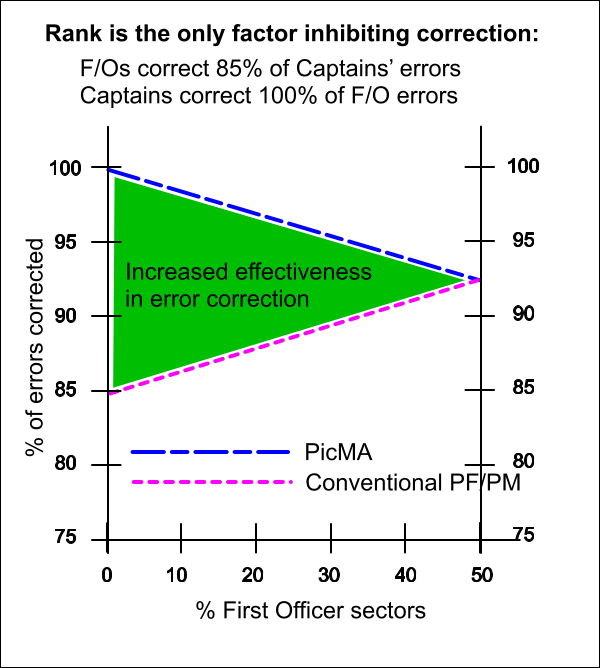"We fly leg and leg about anyway"
A common objection to making PicMA the SOP often runs along these lines: “Yes, in theory you might get more effective error correction if the SOP has the Captain normally doing the monitoring. But to get that benefit, the Captains would have to do all the takeoffs and landings, and the F/Os all the approaches. We want our F/Os to do takeoffs and landings as well, so we fly ‘leg and leg about’.
So in our operation, the F/Os are already doing half the flying and the Captains are already doing half the monitoring. We want to continue our "leg and leg" policy. So adopting a PicMA procedure as SOP wouldn’t have any impact: we’d just reverse most of the occasions when each is flying, without changing the overall effectiveness.”
This objection is highly seductive, because superficially it is self-evidently true. However, on examination it will be seen that it is only true if two specific conditions are met, and actually they never are.
The conditions are that:
- all sectors are mandated to be allocated at random on a 50-50 basis between the two pilots
- the only factor in the cross-cockpit authority gradient which inhibits error correction is rank.
In reality these conditions are never met, and in all actual operations there will be a benefit.
To show the flaws in this argument, take a theoretical operation which involves 100 sectors. Assume that it is flown by two-pilot crews, with all pilots of equal competence.
Situation with Traditional PF/PM flying.
Let’s also assume that on every flight the pilot in charge does all the flying (traditional PF/PM operation), and makes one significant mistake. Also assume that the “authority gradient” consists only of the difference in rank. So Captains pick up and correct all errors made by the First Officers, but the F/Os only actually correct 85% of the Captains’ errors. These numbers are exaggerated, purely to illustrate the principle involved.
If the Captains fly all 100 sectors, (i.e. there are ZERO F/O or PICUS sectors), there will be 100 errors made by the Captains. The F/Os will pick up and correct 85 (85%), leaving 15 uncorrected ones. The following diagram shows this as the bottom of the pink line.

What if the Captains “give away” 10 sectors? There will be 90 errors on “their” sectors, of which 85% will be corrected, whilst during the F/Os’ 10 sectors there will be 10 errors, all of which will be corrected. Net result: 13.5 uncorrected errors. (".5" or half errors are of course purely a mathematical concept!)
If the Captains “give away” 20 sectors? There will be 80 errors on “their” sectors, of which 85% (68) will be corrected, whilst during the F/Os’ 20 sectors there will be 20 errors, all of which will be corrected. Net result: 12 uncorrected errors.
This will continue until at the point where 50% of the legs are “given away”, and the uncorrected errors are down to 7.5, or 7.5 % of the total. This follows the lower (red) line on the graph. As Captains give away more flying, the operation becomes safer in terms of effectiveness of monitoring.
Situation using PicMA as standard.
Now imagine the flying which contains “correctable” errors (i.e. other than the actual takeoff and landing) is delegated to the F/Os, as in PicMA. If the Captains “give away” no legs, all the correctable errors are made by the F/Os, and all are corrected. So there are zero uncorrected errors - top of the blue line. Simple arithmetic shows that as Captains give away more legs, the uncorrected error rate will increase until at 50% F/O sectors, again there are 7.5 uncorrected errors, following the upper (blue) line on the graph.
This point where the lines meet on the right side of the graph appears to show that if you do 50-50 "leg and leg" flying, "monitored approaches" indeed produce no benefit, because there are exactly the same number of uncorrected errors.
50% is the MAXIMUM F/O flying.
However, what is being overlooked at this point is that 50% is the MAXIMUM number of legs which will ever be allocated to the F/Os, even under "50/50" leg and leg flying, not the norm or average. For all values of LESS than 50% “First Officers’ sectors” (which is the practical range), there is a safety benefit, shown by the green triangle.
The other factor that undermines the view that "it all evens out with leg-and-leg flying" is what happens if the "cockpit authority gradient" is affected by other factors as well as the Captain-F/O rank aspect, and specifically the "I'm not in charge" factor.